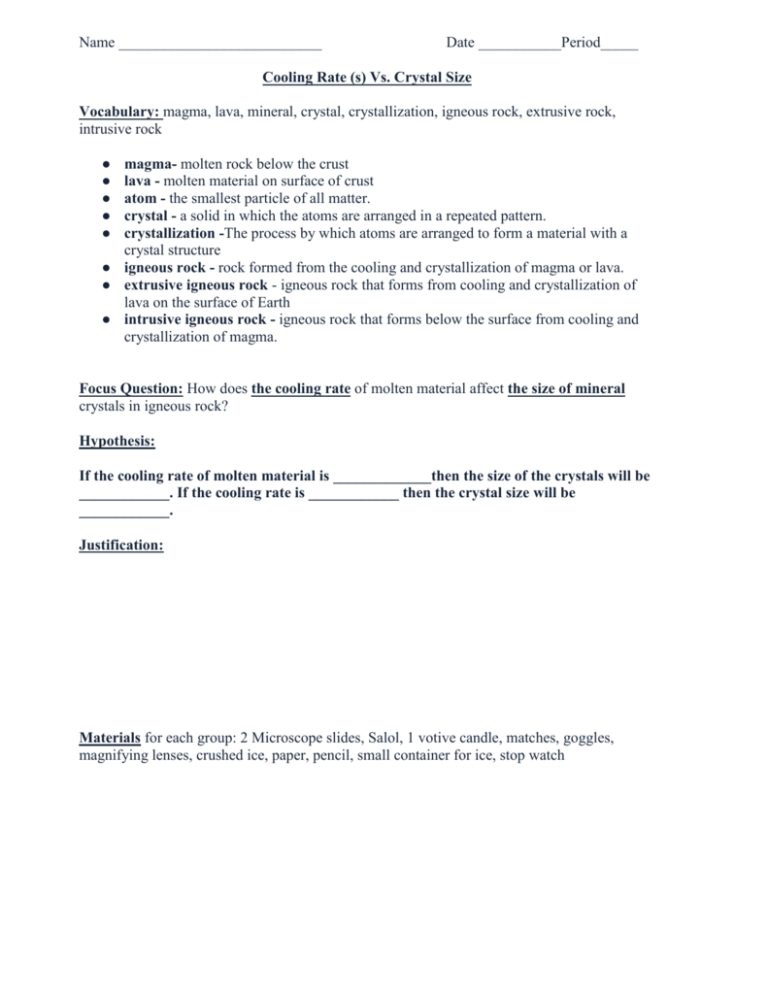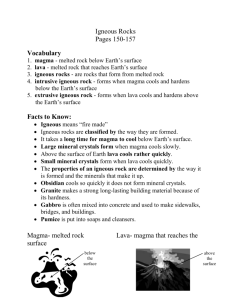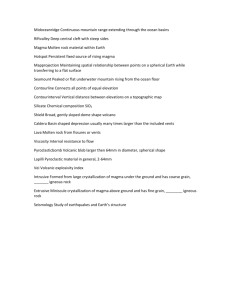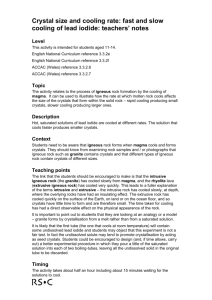Name Date ___________Period
advertisement

Name ___________________________ Date ___________Period_____ Cooling Rate (s) Vs. Crystal Size Vocabulary: magma, lava, mineral, crystal, crystallization, igneous rock, extrusive rock, intrusive rock ● ● ● ● ● magma- molten rock below the crust lava - molten material on surface of crust atom - the smallest particle of all matter. crystal - a solid in which the atoms are arranged in a repeated pattern. crystallization -The process by which atoms are arranged to form a material with a crystal structure ● igneous rock - rock formed from the cooling and crystallization of magma or lava. ● extrusive igneous rock - igneous rock that forms from cooling and crystallization of lava on the surface of Earth ● intrusive igneous rock - igneous rock that forms below the surface from cooling and crystallization of magma. Focus Question: How does the cooling rate of molten material affect the size of mineral crystals in igneous rock? Hypothesis: If the cooling rate of molten material is _____________then the size of the crystals will be ____________. If the cooling rate is ____________ then the crystal size will be ____________. Justification: Materials for each group: 2 Microscope slides, Salol, 1 votive candle, matches, goggles, magnifying lenses, crushed ice, paper, pencil, small container for ice, stop watch Procedure for growing crystals: (Room Temp) 1. Place 3-5g of Salol in the center of 1 glass microscope slide. Spread out evenly in a small circle. 2. Heat the Salol by holding the slide about 2 cm above the flame and gently moving the slide back and forth. When Salol is ALMOST completely melted, remove from the flame and place it on the desk and start the stop watch. (Blow Candle Out) 3. Observe for crystallization and record the time (s) when the first sign of crystallization occurs in Table 1. 4. Continue to record time (s) until all of the melt is crystallized and record the end time (s) in Table 1. 5. Calculate the elapsed time (s) from melt to crystallization (end time-start time) and record. 6. Use the hand lens and /or microscope to observe the size and shape of the crystals and sketch what you see in Table 1. Write additional qualitative observations below data table. 7. Sketch and label the relative shape and size of the crystals in Table 1 and then place this slide aside. (Ice bath) 1. Repeat step 1 above with the second slide. 2. Repeat step 2, but when the Salol is ALMOST melted gently place it on top of the ice bath to cool and start stop watch. 3. Repeat steps 3 – 7. Data: Cooling Environment Crystal Size vs. Cooling Rate(s) Start Time(s) End Time(s) Elapsed (when first (Salol Time(s) crystal completely (end time appeared) crystallized) start time) Crystal Size (Sketch and label key features) Room Temperature Cool Temperature (Ice Bath) Table 1 Additional Qualitative Observations: Explain: Analysis and Conclusion Follow up Questions 1. Identify the material in the experiment to what it represents in geology: _____Solid Salol from room temp a. Molten (melted) rock cooling _____ Solid Salol from ice bath cooling b. Solid intrusive igneous rock _____Candle flame c. Quick cooling form Lava on the surface _____Melted Salol d. Slow cooling from a magma chamber below the surface _____Ice bath cooling e. Solid extrusive rock _____Room temperature cooling f. Heat from the interior of the Earth 2. Refer to the cooling rates (elapsed time) for the Salol samples. How do these differ? Use specific information from the data to support this answer. 3. Observe the mineral crystals on each slide. Describe how each looks. How are the crystals similar and different in appearance? 4. Refer to you hypothesis about the relationship between cooling rate and crystal size. Was your educated guess supported by the data from this activity? Explain using specific information from the data. 5. Below are the pictures of the igneous rocks from the Mystery Samples. Using background information & the knowledge gained through this activity, explain in detail why the two rocks have different sized mineral crystals. (Use the vocabulary words: Lava, magma, intrusive and extrusive, crystallization, crystals in explanation) Figure 1 Igneous rock sample 6 with large mineral Figure 2 Igneous rock sample 1 with small mineral crystals. crystals. 6. Explain at least 2 ways this model of crystallization is similar to the process of crystallization in igneous rocks and at least 2 ways that it is different.









